Aichi D3A
| D3A Val | |
|---|---|
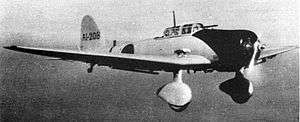 | |
| Aichi D3A1 from carrier Akagi. | |
| Role | Carrier-based dive bomber |
| Manufacturer | Aichi Kokuki KK |
| First flight | January 1938 |
| Introduction | 1940[1] |
| Primary user | Imperial Japanese Navy |
| Number built | 1,495 (479 D3A-1) (1016 D3A-2) |

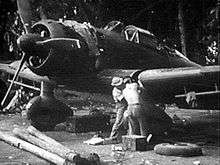

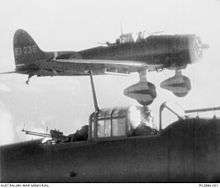
The Aichi D3A Type 99 Carrier Bomber, (Allied reporting name "Val")[2] was a World War II carrier-borne dive bomber. It was the primary dive bomber of the Imperial Japanese Navy (IJN), and participated in almost all IJN actions, including the attack on Pearl Harbor. The Aichi D3A was the first Japanese aircraft to bomb American targets in the war, commencing with Pearl Harbor and U.S. bases in the Philippines, such as Clark Air Force Base. Vals sank more Allied warships than any other Axis aircraft,[3][4][5] despite being considered obsolescent when the war started.
Design and development
In mid-1936, the Japanese Navy issued the 11-Shi specification for a monoplane carrier-based dive bomber to replace the existing D1A biplane currently in service.[1] Aichi, Nakajima, and Mitsubishi all submitted designs, and Aichi and Nakajima were both asked for two prototypes each.
The Aichi design started with low-mounted elliptical wings inspired by the Heinkel He 70 Blitz. It flew slowly enough that the drag from the landing gear was not a serious issue, so fixed gear was used for simplicity.[6] The aircraft was to be powered by the 529 kW (709 hp) Nakajima Hikari 1 nine-cylinder radial engine.
The first prototype was completed in December 1937, and flight trials began a month later. Initial tests were disappointing. The aircraft was underpowered and suffered from directional instability in wide turns, and in tighter turns it tended to snap roll. The dive brakes vibrated heavily when extended at their design speed of 200 knots (370 km/h), and the Navy was already asking for a faster diving speed of 240 knots (440 km/h).[7]
The second aircraft was extensively modified prior to delivery to try to address the problems. Power was increased by replacing the Hikari with the 626 kW (839 hp) Mitsubishi Kinsei 3 in a redesigned cowling, and the vertical tail was enlarged to help with the directional instability. The wings were slightly larger in span and the outer sections of the leading edges had wash-out to combat the snap rolls, and strengthened dive brakes were fitted. These changes cured all of the problems except the directional instability, and it was enough for the D3A1 to win over the Nakajima D3N1.[8]
Operational history
In December 1939, the Navy ordered the aircraft as the Navy Type 99 Carrier Bomber Model 11 (kanjō bakugekiki, usually abbreviated to 艦爆 kanbaku.[9]). The production models featured slightly smaller wings and increased power in the form of the 746 kW (1,000 hp) Kinsei 43 or 798 kW (1,070 hp) Kinsei 44. The directional instability problem was finally cured with the fitting of a long dorsal fin-strake which started midway down the rear fuselage, and the aircraft actually became highly maneuverable.[10]
Armament was two forward-firing 7.7 mm (0.303 in) Type 97 machine guns, and one flexible 7.7 mm (.303 in) Type 92 machine gun in the rear cockpit for defense. Normal bombload was a single 250 kg (550 lb) bomb carried under the fuselage, swung out under the propeller on release by a trapeze. Two additional 60 kg (130 lb) bombs could be carried on wing racks located under each wing outboard of the dive brakes.[11]
The D3A1 commenced carrier qualification trials aboard the aircraft carriers Akagi and Kaga during 1940, while a small number of aircraft made their combat debut from land bases over China.[10] Starting with the attack on Pearl Harbor, the D3A1 took part in all major Japanese carrier operations in the first 10 months of the war. They achieved their first major success against the Royal Navy during their Indian Ocean raid in April 1942. Val dive bombers scored over 80% hits[12] with their bombs during attacks on two heavy cruisers and an aircraft carrier during the operation. During the course of the war, Val dive bombers often combined their attacks upon enemy warships with the IJN Kate torpedo bomber; consequently enemy vessels were often sunk by a combination strike of bombs and torpedoes. However, there were occasions when just the Vals would make the attacks, or at least score the sinking hits. Discounting the Pearl Harbor strike, which also used the Nakajima B5N for level bombing and torpedo attacks, Val dive bombers were credited with sinking the following Allied warships:[13]
- USS Peary, American destroyer, 19 February 1942 – Australia (Darwin)[14]
- USS Pope, American destroyer, 1 March 1942 – Pacific Ocean
- HMS Cornwall, British heavy cruiser, 5 April 1942 – Indian Ocean
- HMS Dorsetshire, British heavy cruiser, 5 April 1942 – Indian Ocean
- HMS Hector, British armed merchant cruiser, 5 April 1942 – Indian Ocean
- HMS Tenedos, British destroyer, 5 April 1942 – Indian Ocean
- HMS Hermes, British aircraft carrier, 9 April 1942 – Indian Ocean
- HMAS Vampire, Australian destroyer, 9 April 1942 – Indian Ocean
- USS Sims, American destroyer, 7 May 1942 – Pacific Ocean
- USS De Haven, American destroyer, 1 February 1943 – Pacific Ocean
- USS Aaron Ward, American destroyer, 7 April 1943 – Pacific Ocean
- USS Brownson, American destroyer, 26 December 1943 – Pacific Ocean[15]
- USS Abner Read, American destroyer, sunk by kamikaze 1 November 1944 – Pacific Ocean[16]
- USS William D. Porter, American destroyer, sunk by kamikaze 10 June 1945 – Japan (Okinawa)
As the war progressed, there were instances when the dive bombers were pressed into duty as fighters in the interceptor role, their maneuverability being enough to allow them to survive in this role.[17] In June 1942, an improved version of the D3A powered by a 969 kW (1,299 hp) Kinsei 54 was tested as the Model 12. The extra power reduced range, so the design was further modified with additional fuel tanks to bring the total tankage to 900 L (240 US gal), giving it the range needed to fight effectively over the Solomon Islands. Known to the Navy as the Model 22, it began to replace the Model 11 in front-line units in autumn 1942, and most Model 11s were then sent to training units.
When the Yokosuka D4Y Suisei became available, the D3A2s ended up with land-based units or operating from the smaller carriers, which were too small to handle the fast-landing Suisei. When American forces recaptured the Philippines in 1944, land-based D3A2s took part in the fighting, but were hopelessly outdated and losses were heavy. By then, many D3A1s and D3A2s were operated by training units in Japan, and several were modified with dual controls as Navy Type 99 Bomber Trainer Model 12s (D3A2-K). During the last year of the war, the D3A2s were pressed back into combat for kamikaze missions.[18]
Operators
Survivors
One D3A is currently under restoration at the Planes of Fame Museum in Chino, California.[19] There are two unrestored D3As on display at the National Museum of the Pacific War in Fredericksburg, Texas.[20][21]
Specifications (D3A1)
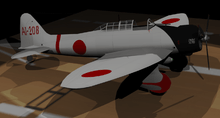
General characteristics
- Crew: Two (pilot and gunner)
- Length: 10.2 m (33 ft 5 in)
- Wingspan: 14.37 m (47 ft 2 in)
- Height: 3.85 m (12 ft 8 in)
- Wing area: 34.9 m² (375.6 ft²)
- Empty weight: 2,408 kg (5,309 lb)
- Max. takeoff weight: 3,650 kg (8,047 lb)
- Powerplant: 1 × Mitsubishi Kinsei 44, 798 kW (1,070 hp)
Performance
- Maximum speed: 389 km/h (205 kn, 242 mph (389 km/h))
- Range: 1,472 km (795 nmi, 915 mi (1,473 km))
- Service ceiling: 9,300 m (30,500 ft)
Armament
- 2 × fixed, forward-firing 7.7 mm (0.303 in) Type 97 machine guns
- 1 × flexible, rearward-firing 7.7 mm (0.303 in) Type 92 machine gun
- 1 × 250 kg (551 lb) or 2 × 60 kg (132 lb) bombs
Specifications (D3A2)

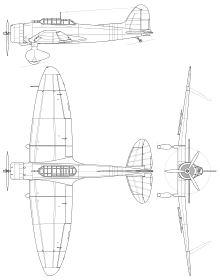
Data from [1]
General characteristics
- Crew: Two (pilot and gunner)
- Length: 10.2 m (33 ft 5.4 in)
- Wingspan: 14.37 m (47 ft 2 in)
- Height: 3.8 m (12 ft 7.5 in)
- Wing area: 34.9 m² (375.6 ft²)
- Empty weight: 2,570 kg (5,666 lb)
- Max. takeoff weight: 4,122 kg (9,100 lb)
- Powerplant: 1 × Mitsubishi Kinsei 54, 969 kW (1,300 hp)
Performance
- Maximum speed: 430 km/h (232 kn, 267 mph (430 km/h))
- Range: 1,352 km (730 nmi, 840 mi (1,350 km))
- Service ceiling: 10,500 m (34,450 ft)
- Rate of climb: 8.62 m/s (1,869.685 ft/min)
Armament
- 2 × fixed, forward 7.7 mm (0.303 in) Type 97 machine guns
- 1 × flexible, rearward-firing 7.7 mm (0.303 in) Type 92 machine gun
- 1 × 250 kg (551 lb) and 2 × 60 kg (132 lb) bombs
See also
- Aircraft of comparable role, configuration and era
- ANBO VIII
- Blackburn Skua
- Breda Ba.65
- Curtiss SB2C Helldiver
- Douglas SBD Dauntless
- Fairey Barracuda
- Junkers Ju 87
- Saab 17
- Vultee A-31 Vengeance
- Yokosuka D3Y
- Yokosuka D4Y
- Related lists
References
- Notes
- 1 2 3 Chant 1999, p. 16.
- ↑ Note: This code name was applied mid-to-late 1943; more often the D3A was referred to as the "Type 99 navy dive bomber" by Allied forces.
- ↑ Angelucci and Matricardi 1978, p. 142.
- ↑ Worth 2001, p. 170.
- ↑ Casey 1977, p. 87.
- ↑ Francillon 1979, p. 272.
- ↑ Francillon 1979, pp. 272–273.
- ↑ Francillon 1969, p. 24.
- ↑ Parshall and Tully 2007, p. 80.
- 1 2 Air International December 1987, p. 289.
- ↑ Air International December 1987, p. 288.
- ↑ Francillon 1979, p. 274.
- ↑ Brown 1990, pp. 60–125.
- ↑ Roscoe 1953, p. 96
- ↑ Parkin 1995, p. 198.
- ↑ Parkin 1995, p. 251.
- ↑ Francillon 1969, p. 25.
- ↑ Air International December 1987, p. 290.
- ↑ "Restoration Projects". Planes of Fame Museum. Retrieved: 7 December 2010.
- ↑ Taylan, Justin. "D3A2 Model 22 Val Manufacture Number 3357 Tail 582–248". Pacific Wrecks. Pacific Wrecks Inc. Retrieved 19 August 2016.
- ↑ Taylan, Justin. "D3A2 Model 22 Val Manufacture Number 3105". Pacific Wrecks. Pacific Wrecks Inc. Retrieved 19 August 2016.
- Bibliography
- Angelucci, Enzo and Paolo Matricardi. World Aircraft: World War II, Volume II (Sampson Low Guides). Maidenhead, UK: Sampson Low, 1978. ISBN 0-562-00096-8.
- Brown, David. Warship Losses of World War Two. London: Arms and Armour, 1990. ISBN 0-85368-802-8.
- Casey, Louis S. Naval Aircraft. Secaucus, New Jersey: Chartwell Books Inc., 1977. ISBN 0-7026-0025-3.
- Chant, Christopher. Aircraft of World War II – 300 of the World's Greatest Aircraft 1939–45. London: Amber Books Ltd., 1999. ISBN 0-7607-1261-1.
- Eden, Paul. "The Encyclopedia of Aircraft of WWII".London:Amber Books Lt., 2007. ISBN 1-904687-83-0.
- Fleischer, Seweryn and Zygmunt Szeremeta. Aichi D3A Val, Nakajima B5N Kate (in Polish). Warszawa, Poland: Wydawnictwo Militaria, 2001. ISBN 83-7219-118-2.
- Francillon, René J. Japanese Aircraft of the Pacific War. London: Putnam & Company Ltd., 1970 (2nd edition 1979). ISBN 0-370-30251-6.
- Francillon, René J. Japanese Bombers of World War Two, Volume One. Windsor, Berkshire, UK: Hylton Lacy Publishers Ltd., 1969. ISBN 0-85064-022-9.
- Kinzey, Bert. Attack on Pearl Harbor: Japan awakens a Sleeping Giant. Blacksburg, Virginia: Military Aviation Archives, 2010. ISBN 978-0-9844665-0-4.
- "Pacific Predator... the Aichi Type 99". Air International, Vol. 33, No. 6, December 1987, pp. 285–290. Bromley, UK: Fine Scroll. ISSN 0306-5634.
- Parkin, Robert S. Blood on the Sea: American Destroyers Lost in World War II. New York: Sarpedon Publishing, 1995. ISBN 1-885119-17-8.
- Parshall, Jonathan and Anthony Tully. Shattered Sword: The Untold Story of the Battle of Midway. Washington D.C.: Potomac Books Inc., 2007. ISBN 978-1-57488-924-6.
- Richards, M.C. and Donald S. Smith. "Aichi D3A ('Val') & Yokosuka D4Y ('Judy') Carrier Bombers of the IJNAF". Aircraft in Profile, Volume 13, 1974, pp. 145–169. Windsor, Berkshire, UK: Profile Publications Ltd. ISBN 0-85383-022-3.
- Roscoe, Theodore. United States Destroyer Operations in World War II. Annapolis, Maryland: United States Naval Institute, 1953. ISBN 0-87021-726-7.
- Smith, Peter C. Aichi D3A1/2 Val . Ramsbury, Marlborough, Wiltshire, UK: The Crowood Press Ltd., 1999. ISBN 1-86126-278-7.
- Tagaya, Osamu. Aichi 99 Kanbaku 'Val' Units of World War 2. Botley, UK: Osprey Publications, 2007. ISBN 1-84176-912-6.
- Worth, Richard. Fleets of World War II. New York: Da Capo Press, 2001. ISBN 978-0-306-81116-6.
External links
| Wikimedia Commons has media related to Aichi D3A. |